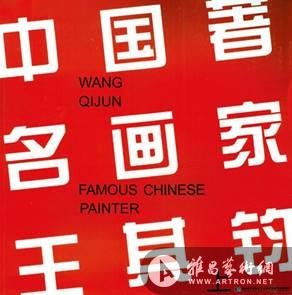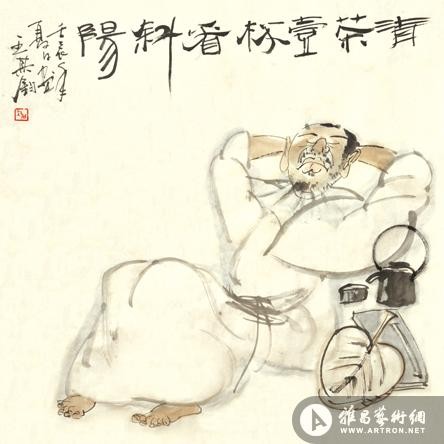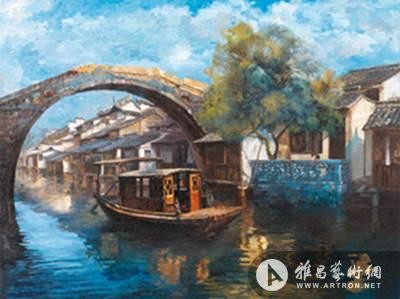Recently the album Wang Qijun, Famous Chinese Painter was published by Jilin Fine Arts Press which ranks among the "National Top 100 Publishers". Divided into altogether 2 volumes, it houses traditional Chinese paintings and calligraphies in Volume 1 and oil paintings in Volume 2. This album of painting collects the new works of Professor Wang Qijun from the Central Academy of Fine Arts, displaying the features of his latest paintings and calligraphies.

The cover page of the volums
Wang Qijun is an artist of significant accomplishments both in fine arts and calligraphy. As for calligraphy, his running script sharply varies based on traditional styles, encompassing both the relaxation of Zhang Xu (675-750) and the wildness of Huai Su (725-785) and implying exceedingly aesthetic and delightful beauty. It takes deep roots in his learning from the model of calligraphy since his childhood which constituted the fundamental elements of his calligraphy. The composition of his running script is renowned for lively art with each character featuring varying sizes, well-proportioned line spacing, perfectly-arranged density, appropriate intensity and most importantly tremendous individualities.
His clerical script follows the extraordinary style of tablet inscription written on Chinese silk in the Han Dynasty. Traditional models of calligraphy for clerical script primarily source from Zhang Qian Inscription (inscribed in 186) and Cao Quan Inscription (inscribed in 185). Nonetheless Han Dynasty wooden tablets and silk were successively unearthed after the Cultural Revolution, which presented the modern people the opportunity to witness the writing style in the Han Dynasty. The clerical script of Wang Qijun makes great efforts to pursue the unsophisticated structure and unconventional pattern, radically averting from the common besetting shortages of stiffness and characterizing vivaciousness, efficiency, creativeness and uncomplicatedness. The running style and the clerical style compose the two major constituents of his calligraphy.

A traditional Chinese Painting, which is titled See the Sunset.
Wang Qijun worked in the Institute of Traditional Chinese Painting in his early years, which helped his traditional Chinese paintings demonstrate the essentials of his writings and paintings. He has painted numerous picture-story books, so his traditional Chinese paintings manifestly show the foundation of his technique for character modeling and line presentation. He highly praises the advocacy to take calligraphy as the basis of painting. The strokes and the lively spirit and charm of his traditional Chinese paintings are inherent and the scholarly disposition rests at the core of his paintings.
The techniques of the art of composition and lines function merely as the external form of his traditional Chinese painting and calligraphy with his literary cultivation deeply hidden in his art. We are easily touched by the themes of his paintings when we enjoy this album. The themes are mostly sourced from literary quotations of philosophy, humor, scoff, self-mockery or implication. Watching his paintings is just like nothing but reading prose. "Watching the clouds by the window and listening to the rain on the bed." The watchers will "view the world in contemplation and taste the life in detail" together with the painter.
The oil paintings in this album still follow the true-life style, inheriting the European neo-classicistic painting style and the USSR realistic presentation style. His oil paintings are principally themed on figures and the scenery in the Yangtze River Delta. In terms of figures, the album collects several works of Wang Qijun when he participated in the activity "Image Talk about Khampa" (painting and creating from life in the Tibetan area in Sichuan) held by the artists of the Central Academy of Fine Arts, such as Learning the Tibetan Language and Season's Greetings etc. These works demonstrate the scenes in today's real life, for instance, the joyful facial expressions of an old Tibetan woman during her talking with her child far away over the mobile phone and the scene of pre-school children and stay-at-home women learning to read and write in standard Tibetan in class, vivifying the new life of the people of western Sichuan and Tibet. Yangtze River Delta stands as the constant theme of the creation of Wang Qijun, which is closely related with his academic background of doctoral degree in Architectural History and Theory of the School of Architecture of Tsinghua University. As an expert in research on traditional Chinese residence, he has once won the Grand Prize of Book in Chinese mainland and Taiwan with his academic works on dwellings which were translated and published in German, French, Japanese and English and his English works Chinese Architecture has been published in New York. Slowly Rowing, the works on the first page of Wang Qijun, Famous Chinese Painter Volume 2, created in 2013, a typical oil painting depicting the Yangtze River Delta representing his latest works, was auctioned at the Poly Auction Fair in the autumn of 2013.

Slowly Rowing, an oil painting on canvas
Copyright Reserved 2000-2025 雅昌艺术网 版权所有
增值电信业务经营许可证(粤)B2-20030053广播电视制作经营许可证(粤)字第717号企业法人营业执照
 京公网安备 11011302000792号粤ICP备17056390号-4信息网络传播视听节目许可证1909402号互联网域名注册证书中国互联网举报中心
京公网安备 11011302000792号粤ICP备17056390号-4信息网络传播视听节目许可证1909402号互联网域名注册证书中国互联网举报中心
网络文化经营许可证粤网文[2018]3670-1221号网络出版服务许可证(总)网出证(粤)字第021号出版物经营许可证可信网站验证服务证书2012040503023850号